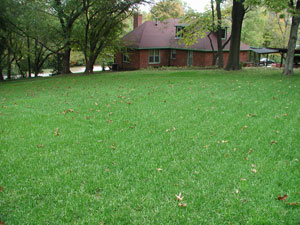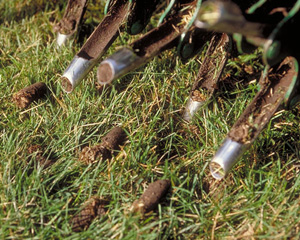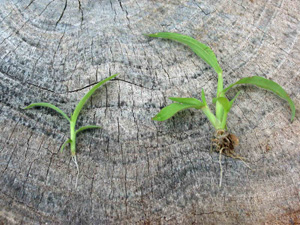Taking an environmentally sensitive approach to pest management
Spring Lawn Care – Aeration, Fertility and Crabgrass Control
Published: March 15, 2012

Tall fescue lawn with excellent mowing height and density. Lawns of this quality will reduce annual weed populations up to 80 percent.
Early spring is an excellent time to give home lawns a jump-start with aeration and fertility. Cool-season grasses, such as bluegrass, fescue and ryegrass grow favorably during the cooler weather of spring and fall. Improving air, water and nutrient movement through the soil during this time significantly increases the quality of the grass.
Aeration reduces soil compaction, increases air exchange and allows water to infiltrate more quickly into the soil profile, therefore creating better root mass. Increasing root mass at this time of the year greatly improves the chances of cool-season grasses to reduce stress and survive the heat and drought of summer.
Aeration equipment can be found at local rental stores or garden centers. A machine that pulls a ½" diameter plug three to four inches deep on three to four inch centers will do an excellent job. Machines that force hollow tines into the soil are better than pull-type drums with spoon tines. Not all machines will meet these specifications; however any amount of aeration is better than no aeration.
Applications of fertilizer after aeration will move nutrients immediately into the root-zone of your lawn. This practice has shown excellent results in the density and color of cool-season turfgrasses in preparation for summer stress.
Fertilizer types available to homeowners come in a wide variety. Most are considered quick release forms, meaning they are readily soluble and immediately available to the plant. Any one of these would work for early spring applications. Applying ½ to ¾ pound of nitrogen per 1,000 square feet would be acceptable from early March to early April. All fertilizers sold over the counter will have recommendations for rate of application, usually based on square footage. In that case, it would be important to know the square footage of your home lawn and make sure the proper amount of fertilizer goes down per specified area.

Lawn aeration will reduce soil compaction, and open the soil surface allowing air, water and nutrient to enter the root-zone.
When caring for your lawn and trying to keep it 'weed-free' the saying that "the best defense is a good offense" holds true. Weeds are opportunistic and invade weakened lawns, thus the best weapon to fight weeds is a dense, healthy stand of grass. There are several good management practices that give lawns a fighting chance against weeds, such as planting the appropriate grass for a particular location, re-seeding bare areas in the fall, proper fertilizing, proper mowing (three to four inches tall) and proper watering. The height of mowing influences competition against weeds such as crabgrass - the higher the cut the lower the crabgrass infestation. Spring watering should not be a frequent practice if we have normal spring rains. Frequent light sprinkling encourages shallow-rooted weed seed germination.
Crabgrass is a summer annual grassy weed. It is a course, textured grass that germinates in the spring and grows well throughout the heat of the summer. Its wide leaf blades, heat tolerance, and prostrate growth habit make it an eyesore in the lawn and allow it to smother desirable turfgrasses. During the summer crabgrass will produce seed heads even at low mowing heights. Crabgrass plants will be killed by the first hard frost in the fall, and will drop their seed heads. In the spring, new crabgrass seedlings emerge around the previous year's plants, unless this open space was over-seeded in the fall with a desired turfgrass or a pre-emergent herbicide is applied this spring.
Pre-emergent herbicides are so-named because they must be in place before crabgrass seedlings and other weeds begin to emerge. As a general rule, crabgrass may begin to germinate when daily high temperatures begin to reach 70 oF or above. In southern Missouri this may occur as early as mid-March; in central and northern Missouri this may not be until late March or early April. However, there are exceptions to this rule. Looking at this winter and spring being so mild, pre-emergence herbicides were being applied throughout March. Highest crabgrass emergence begins to occur as daily high temperatures reach 80 oF. A natural guide, specific to each year's fluctuating weather patterns, is to have your pre-emergent herbicide in place before the yellow blooms of the Forsythia have all dropped. It is now the second week of March and Forsythia are in bloom in central Missouri.

Crabgrass will emerge when five consecutive days reach 70 F. If pre-emergence applications were missed, early post-emergence application should be made to young crabgrass (left – 1 to 3 leaf stage). The plant on the right is in a 3 tiller stage.
Most pre-emergent herbicides will not kill crabgrass that has already emerged. They must be applied and watered in to develop that herbicide barrier before weed seed germination. Many effective products are available, almost all of which are combinations of fertilizer with the pre-emergent herbicide (or crabgrass preventer).
Many over-the-counter products are available to you at several garden centers, hardware stores, farm centers and nurseries. Crabgrass preventers containing Dimension (dithiopyr), Pre-M (pendimethalin) or Barricade (prodiamine) are excellent choices for the control of crabgrass, other summer annual grassy weeds and some summer annual broadleaf weeds. Dimension is the only pre-emergence herbicide that offers some post-emergence activity as well. It works best if crabgrass is small (one to three leaf stage). If you missed the optimum time for pre-emergence applications, there are several post-emergence products on the market today that are very effective. These new combination products will control young crabgrass and many broadleaf weeds. Quinclorac is the active ingredient for post crabgrass control and is usually in combination with 2,4-D, MCPP and/or dicamba.
Always read the label directions carefully when applying lawn care products. Do not over apply, either by excessive overlapping or applying more product than recommended to a specific area. Applying too much product could result in damage to turfgrass roots or other non-target plants. Determine the effective application width of your rotary spreader and space out each spreader pass to ensure uniform coverage with minimal overlap. It is also recommended to apply one-half of the rate required in two directions. This allows better distribution of the product and avoids striping. Do not spread crabgrass preventers into ornamental, flower or garden beds; they will restrict rooting of new plantings.
Subscribe to receive similar articles sent directly to your inbox!
REVISED: September 29, 2015